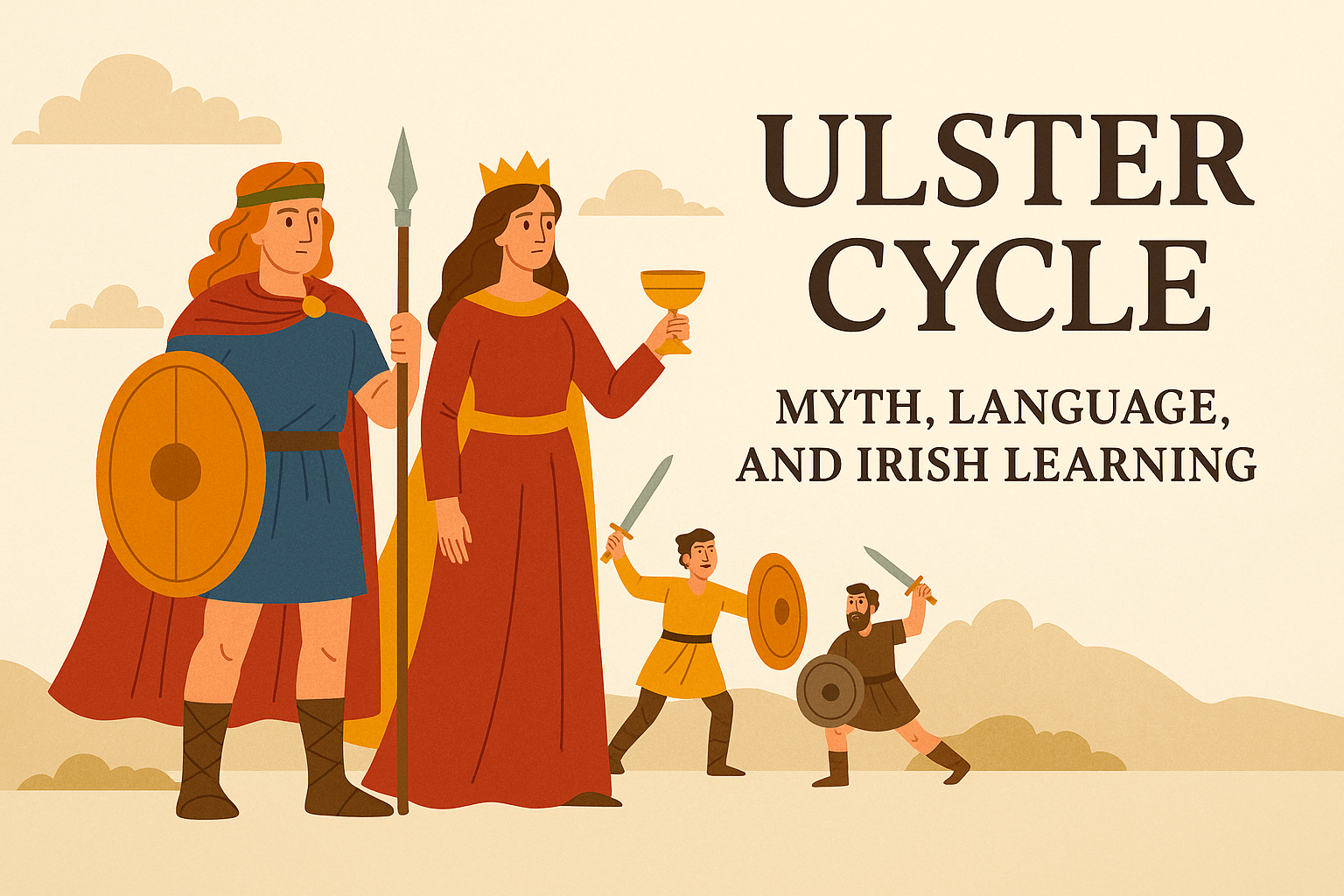The Ulster Cycle is one of the great collections of medieval Irish mythology, brimming with tales of warriors, gods, and legendary battles. These stories—rich with characters like Cú Chulainn, Queen Medb, and Conchobar mac Nessa—are not just epic adventures, but also linguistic treasures. Written in early forms of the Irish language, they give us a direct window into Ireland’s cultural and linguistic heritage.
For learners of Irish today, the Ulster Cycle offers more than mythology. It provides an opportunity to engage with authentic historical texts, deepen cultural understanding, and explore the rhythms of a language that has carried Ireland’s stories for centuries. At Gaeilgeoir AI, our mission is to make such connections between language and culture accessible through AI-powered tools that guide learners on their journey.
What Is the Ulster Cycle?
The Ulster Cycle is one of the four major cycles of Irish mythology, alongside:
- The Mythological Cycle – tales of the Tuatha Dé Danann and the creation myths of Ireland.
- The Fenian Cycle – heroic adventures of Fionn mac Cumhaill and his warriors.
- The Historical Cycle – stories about the legendary kings of Ireland.
The Ulster Cycle focuses on the warriors of the kingdom of Ulster, especially during the reign of King Conchobar. The centerpiece of the cycle is the Táin Bó Cúailnge (“The Cattle Raid of Cooley”), a sprawling epic recounting the war sparked by Queen Medb’s attempt to seize a prized bull from Ulster.
Key Themes in the Ulster Cycle
- Heroism and Sacrifice: Cú Chulainn’s feats on the battlefield embody courage and loyalty.
- Conflict and Honor: Much of the cycle revolves around battles, oaths, and rivalries.
- Cultural Identity: The stories preserve names, places, and customs that still resonate in modern Irish culture.
The Ulster Cycle as a Language Resource
For Irish language learners, the Ulster Cycle is more than myth—it’s a living linguistic archive. The tales were preserved in manuscripts like the Book of Leinster and the Lebor na hUidre (“Book of the Dun Cow”), written in Old and Middle Irish. Studying these works can help learners:
- Recognize Ancient Vocabulary: Words that survive in today’s Irish often appear in their earlier forms.
- Appreciate Dialects: Some Ulster traditions highlight linguistic differences that still exist in Ulster Irish today.
- Deepen Cultural Context: Understanding stories in their original language provides insight into idioms, phrasing, and worldview.
If you’d like a broader foundation before diving into mythological texts, check out our Ancient Irish Language Guide, which introduces the basics of Old and Middle Irish.
Why Myths Help You Learn Irish
You might wonder: why use myth and legend as a learning tool when modern conversations seem more practical? The answer lies in engagement and memory.
1. Stories Stick
Humans remember narratives better than isolated vocabulary lists. The adventures of Cú Chulainn or the cunning strategies of Queen Medb are far more memorable than abstract grammar drills.
2. Vocabulary in Context
When you encounter a phrase in a story, you see it in action—embedded in a cultural and emotional setting. This makes it easier to recall and reuse.
3. Cultural Motivation
Learning Irish isn’t just about communication. It’s about connecting to a heritage that stretches back over a thousand years. The Ulster Cycle gives learners a sense of belonging to something greater.
How Gaeilgeoir AI Can Help
At Gaeilgeoir AI, we use artificial intelligence to make Irish language learning engaging and effective. Imagine:
- Interactive Storytelling: Read simplified retellings of Ulster Cycle tales with AI-powered translations and vocabulary support.
- Smart Flashcards: Automatically generate flashcards from the myths you’re reading.
- Conversational Practice: Chat with an AI partner who can roleplay as characters from Irish legend, helping you practice real dialogue while immersed in mythology.
Our tools bridge the gap between the epic texts of the past and your modern-day learning goals.
Learning from the Ulster Cycle: Practical Tips
Here are a few strategies to make mythology a rewarding part of your Irish learning routine:
1. Start with Summaries
Begin by reading modern English summaries of the Ulster Cycle before tackling Irish versions. This gives you context for new words.
2. Focus on Names and Places
Learn the Irish pronunciation of names like Cú Chulainn (koo-khul-in) or Medb (mayv). Understanding these key words will make the stories feel more familiar.
3. Use AI Assistance
Leverage AI tools to translate unfamiliar words, suggest grammar explanations, and create practice sentences from mythological texts.
4. Practice Retelling
Try retelling parts of the story in your own Irish, even if it’s simple at first. For example:
- Bhí Cú Chulainn láidir agus cróga. (“Cú Chulainn was strong and brave.”)
Connecting Past and Present
The Ulster Cycle reminds us that language is more than communication—it’s the vessel of culture. The words we speak today echo voices from centuries ago, preserved in stories of battles, love, and destiny. By learning Irish, you’re not just memorizing vocabulary. You’re participating in a living tradition that links modern learners to ancient heroes.
For a broader look at how Irish has evolved over the centuries, you might enjoy our article on the History of Learning Gaeilge.
Conclusion: Begin Your Journey with Myth and Language
The Ulster Cycle is more than a mythological treasure—it’s an invitation to explore Irish culture and language in one of its most authentic forms. By combining ancient stories with modern tools, you can make learning Irish both meaningful and enjoyable.
Whether you’re curious about medieval manuscripts or simply inspired by tales of legendary warriors, the Irish language opens the door to a deeper connection with Ireland’s heritage.
👉 Ready to begin? Sign up today and let Gaeilgeoir AI guide you on your path—from ancient epics to everyday Irish conversation.


